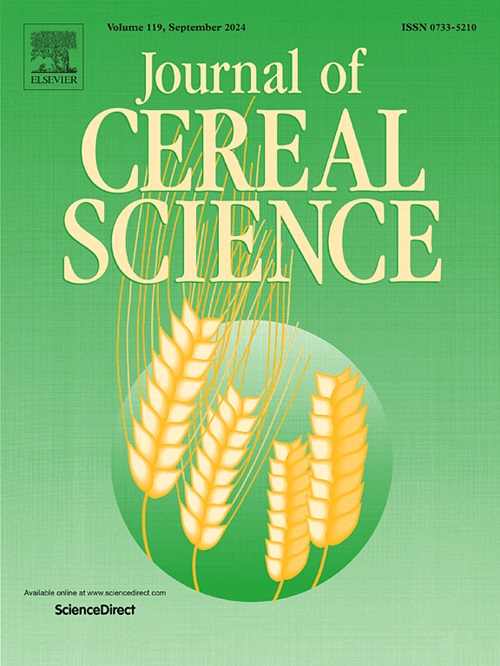Comparative study on the quality characteristics of filter flours collected from different milling streams in a wheat flour milling system
IF 3.7
2区 农林科学
Q2 FOOD SCIENCE & TECHNOLOGY
引用次数: 0
Abstract
This study investigated filter flours extracted from different milling streams in a flour mill, including filter flour from the first milling stream (QF), the final milling stream (HF), and the flour blending system (PF), as well as finisher flour (DF), with wheat flour (F) used as the control sample. The quality characteristics of the different flours, including their structural and physicochemical properties were analyzed. The values of G′ and G″ for the filter flours were both greater than those of wheat flour. The farinograph and extensograph properties of filter flours vary significantly. None of the filter flours had a whiteness higher than that of wheat flour. The starch content (27.99–75.36 %) of the filter flours was lower than that of wheat flour. The gluten index (68.37–91.06 %) and relative crystallinity (10.39–18.68 %) of the filter flours were higher than those of wheat flour, except in the case of QF, with the highest gluten index observed in PF. The peak viscosities ranged from 43.5 cp (DF) to 1077 cp (PF), while the peak temperatures were all higher than that of wheat flour, varying from 57.65 °C (QF) to 59.74 °C (DF). A total of 28 volatile flavor compounds were detected in the filter flours, with DF showing a relatively large difference from the others. These results indicate significant quality differences among the filter flours from different milling streams. This study provides a theoretical basis for the rational utilization of filter flour to increase economic benefits and to precisely determine the specific applications of filter flour from different milling streams.

小麦粉制粉系统中不同制粉流过滤粉品质特性的比较研究
本研究以小麦粉(F)为对照样本,研究了从面粉厂不同磨粉流程中提取的过滤面粉,包括来自第一磨粉流程(QF)、最终磨粉流程(HF)和面粉混合系统(PF)的过滤面粉,以及精加工面粉(DF)。分析了不同面粉的质量特征,包括结构和理化性质。过滤粉的G′和G″值均大于小麦粉。滤粉的粒度图和拉伸图性质差别很大。过滤面粉的白度均不高于小麦粉。过滤粉的淀粉含量(27.99 ~ 75.36%)低于小麦粉。滤粉的面筋指数(68.37 ~ 91.06%)和相对结晶度(10.39 ~ 18.68%)均高于小麦粉,但高筋粉的面筋指数最高,其峰值粘度范围为43.5 ~ 1077 cp (DF),峰值温度范围为57.65 ~ 59.74℃(DF),均高于小麦粉。过滤面粉中共检测到28种挥发性风味化合物,其中DF与其他成分差异较大。这些结果表明,不同磨粉流程的滤粉质量存在显著差异。该研究为合理利用过滤粉,提高经济效益,准确确定不同制粉流程过滤粉的具体用途提供了理论依据。
本文章由计算机程序翻译,如有差异,请以英文原文为准。
求助全文
约1分钟内获得全文
求助全文
来源期刊

Journal of Cereal Science
工程技术-食品科技
CiteScore
7.80
自引率
2.60%
发文量
163
审稿时长
38 days
期刊介绍:
The Journal of Cereal Science was established in 1983 to provide an International forum for the publication of original research papers of high standing covering all aspects of cereal science related to the functional and nutritional quality of cereal grains (true cereals - members of the Poaceae family and starchy pseudocereals - members of the Amaranthaceae, Chenopodiaceae and Polygonaceae families) and their products, in relation to the cereals used. The journal also publishes concise and critical review articles appraising the status and future directions of specific areas of cereal science and short communications that present news of important advances in research. The journal aims at topicality and at providing comprehensive coverage of progress in the field.
 求助内容:
求助内容: 应助结果提醒方式:
应助结果提醒方式:


